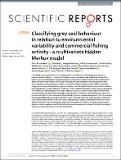Classifying grey seal behaviour in relation to environmental variability and commercial fishing activity - a multivariate hidden Markov model
Abstract
Classifying movement behaviour of marine predators in relation to anthropogenic activity and environmental conditions is important to guide marine conservation. We studied the relationship between grey seal (Halichoerus grypus) behaviour and environmental variability in the southwestern Baltic Sea where seal-fishery conflicts are increasing. We used multiple environmental covariates and proximity to active fishing nets within a multivariate hidden Markov model (HMM) to quantify changes in movement behaviour of grey seals while at sea. Dive depth, dive duration, surface duration, horizontal displacement, and turning angle were used to identify travelling, resting and foraging states. The likelihood of seals foraging increased in deeper, colder, more saline waters, which are sites with increased primary productivity and possibly prey densities. Proximity to active fishing net also had a pronounced effect on state occupancy. The probability of seals foraging was highest <5 km from active fishing nets (51%) and decreased as distance to nets increased. However, seals used sites <5 km from active fishing nets only 3% of their time at sea highlighting an important temporal dimension in seal-fishery interactions. By coupling high-resolution oceanographic, fisheries, and grey seal movement data, our study provides a scientific basis for designing management strategies that satisfy ecological and socioeconomic demands on marine ecosystems.
Citation
van Beest , F M , Mews , S , Elkenkamp , S , Schuhmann , P , Tsolak , D , Wobbe , T , Bartolino , V , Bastardie , F , Dietz , R , von Dorrien , C , Galatius , A , Karlsson , O , McConnell , B , Nabe-Nielsen , J , Olsen , M T , Teilmann , J & Langrock , R 2019 , ' Classifying grey seal behaviour in relation to environmental variability and commercial fishing activity - a multivariate hidden Markov model ' , Scientific Reports , vol. 9 , 5642 . https://doi.org/10.1038/s41598-019-42109-w
Publication
Scientific Reports
Status
Peer reviewed
ISSN
2045-2322Type
Journal article
Collections
Items in the St Andrews Research Repository are protected by copyright, with all rights reserved, unless otherwise indicated.

